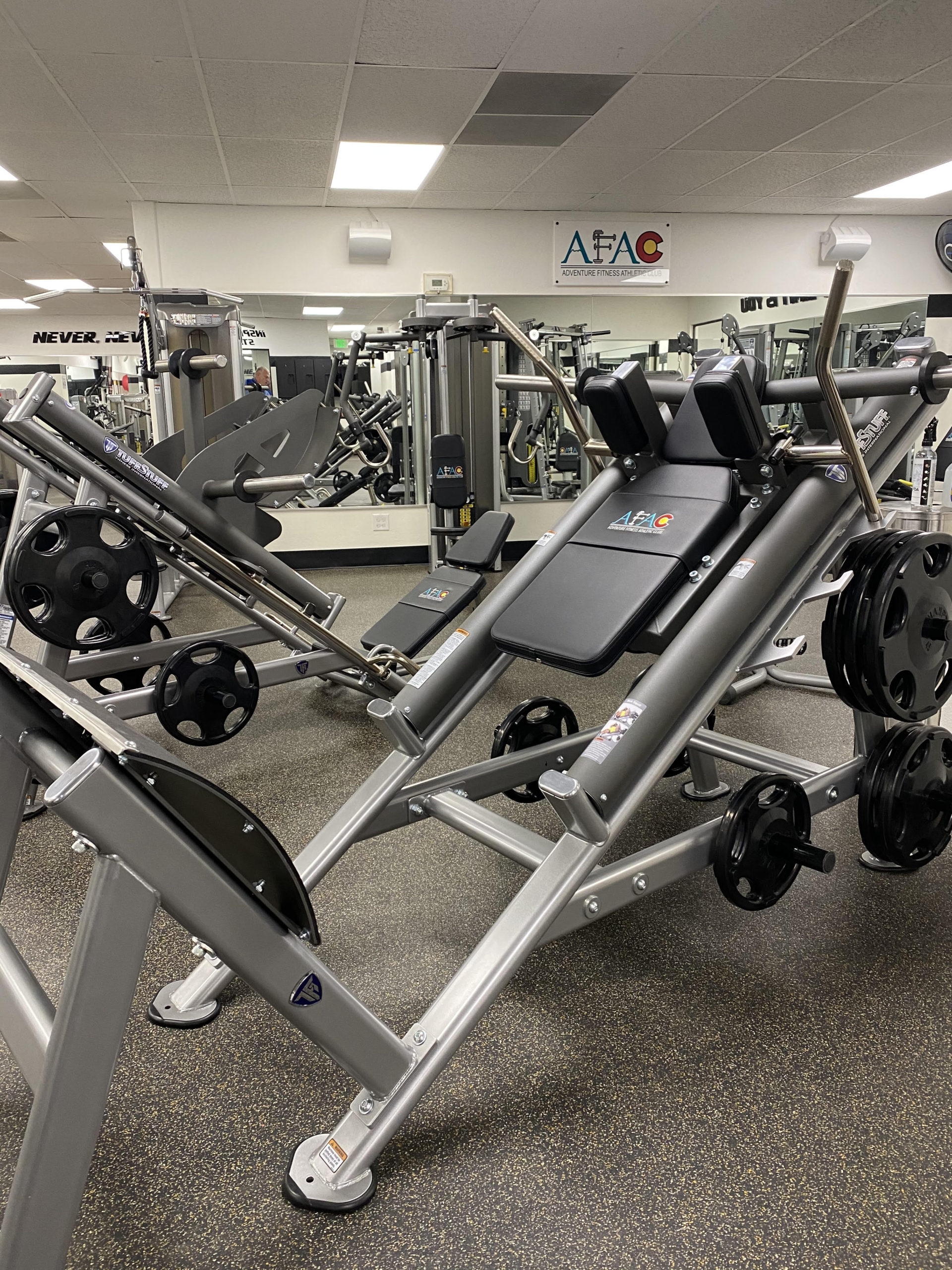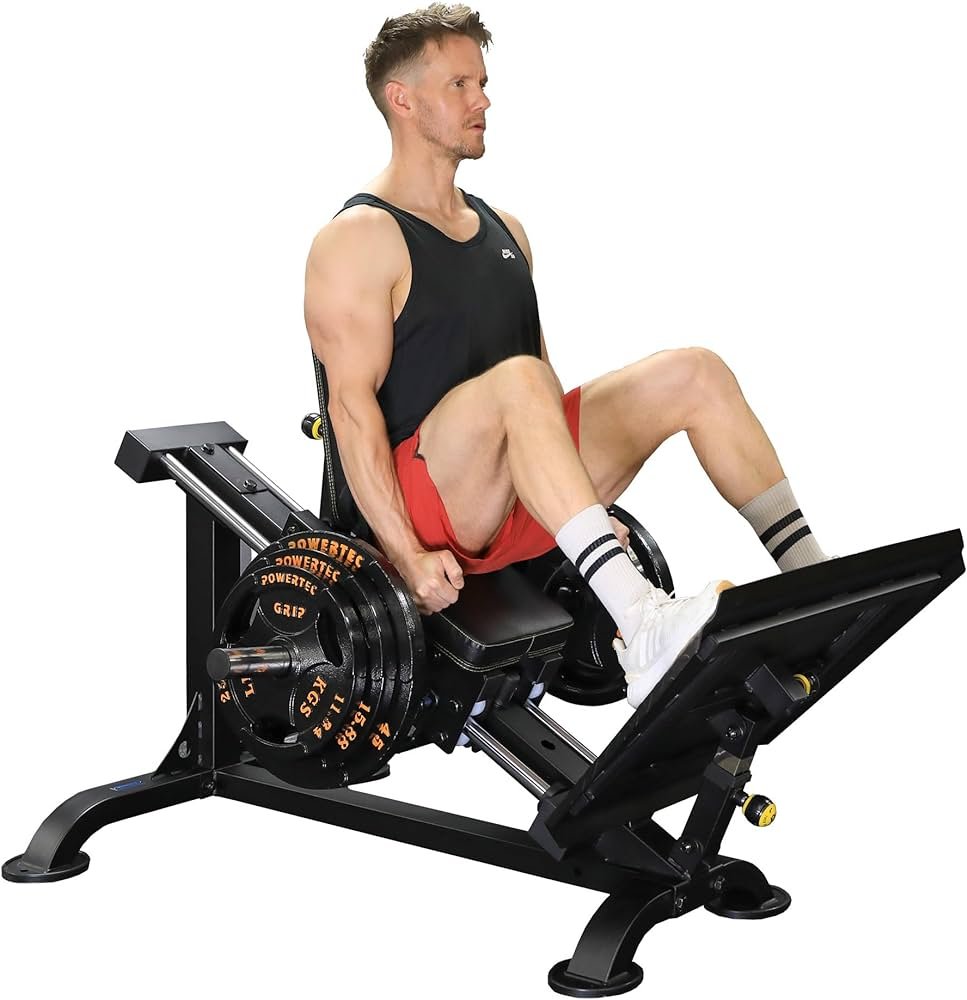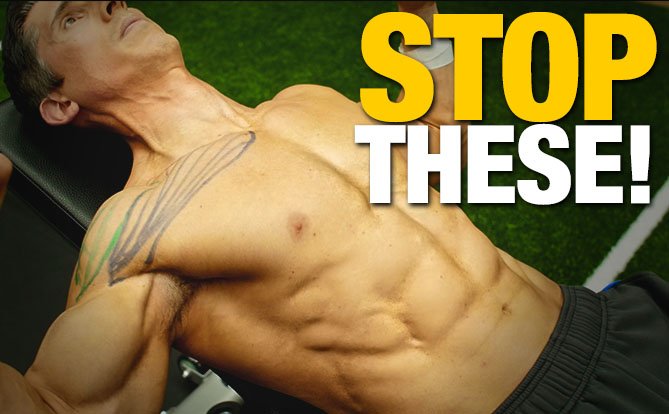To use the leg press, sit on the machine with your back flat against the seat and place your feet shoulder-width apart on the footplate. Press the weight away by extending your legs until they are almost straight, then return to the starting position.
The leg press is an essential exercise for targeting the quadriceps, hamstrings, and glutes, offering a safe way to build lower body strength. The machine provides a guided motion, minimizing the risk of improper form and injury. Beginners may appreciate the straightforward nature of the leg press, which allows for focus on technique and muscle engagement.
Experienced athletes also benefit from the leg press by using it to safely push heavy weights without the balance challenges of free weights. Proper form and controlled movements are key to maximizing the effectiveness of this exercise and reducing strain on the knees. Always adjust the seat and weight to fit your comfort level before starting your set.

Credit: adventurefitness.club
Introduction To Leg Press
Are you ready to level up your leg day? Leg press machines offer a unique challenge for your lower body. Whether you are a beginner or a seasoned gym-goer, it’s vital to know how to use the leg press correctly. Doing so can greatly enhance your workout, ensuring you reap maximum benefits without the risk of injury. Let’s dive into the world of leg pressing and discover how it can transform your fitness routine!
Benefits Of Including Leg Press In Your Routine
Using the leg press machine packs a punch for your fitness goals. It’s more than just another exercise; it’s a powerhouse movement. Why should you include it? Here are the key benefits:
- Boosts Quadriceps Strength: Leg pressing can significantly improve the strength and size of your quads.
- Enhances Glutes: It helps in sculpting a stronger, more defined backside.
- Protects Your Back: This machine supports your back while you push weights, reducing injury risks.
- Adjustable Intensity: You can easily increase or decrease the weight, tailoring the exercise to your fitness level.
Muscle Groups Targeted By Leg Press
Curious about which muscles the leg press works? It’s an incredibly effective lower-body exercise. Here’s a breakdown:
| Muscle Group | Role in Leg Press |
|---|---|
| Quadriceps | Primary movers in extending the knee. |
| Hamstrings | Assist in the movement, providing stability. |
| Gluteus Maximus | Powers the hip extension portion of the exercise. |
| Calves | Engage slightly as you press through your feet. |
| Adductors & Abductors | Stabilize your legs through the press motion. |
Setting Up For Success
Starting your leg press workout right is key to achieving the best results without injury. Before diving into reps, ensure you’ve got the setup perfected. This foundation paves the way for a successful and effective workout. Let’s review each step together.
Choosing The Right Weight
Selecting an appropriate weight is crucial. Start with a weight you can press 10-15 times with some effort. It should feel challenging but not impossible. Use this as a guide:
- Beginners: Light weight to focus on form
- Intermediate: Moderately heavy to push strength
- Advanced: Heavy with control to build muscle
Adjusting The Seat And Footplate
Proper seat and footplate adjustment are critical for comfort and effectiveness. Follow these steps to adjust properly:
- Seat back should allow a slight bend in the knees when fully extended
- Adjust the footplate so it’s at a height allowing a 90-degree knee angle
Safe Positioning Of Feet And Posture
Your feet should be flat on the footplate, hip-width apart. Toes straight or slightly out. Keep your back against the seat during the exercise. Imprint proper form in your mind:
| Position | Focus |
|---|---|
| Feet | Flat and stable |
| Legs | Knees aligned with toes |
| Back | Firmly against the seat |
| Posture | Upright and controlled |
Remember: A correct setup enhances performance and minimizes risk. Focus on the quality of each movement with attention to form.
The Leg Press Technique
The Leg Press is a popular exercise for targeting your lower-body muscles. Proper technique ensures maximum benefits and reduces the risk of injury. Master the leg press with a focus on the correct motion, breathing, and common pitfalls to avoid.
Step-by-step Motion
Begin with your feet shoulder-width apart on the sled. Your toes should point slightly outward. Slowly lower the platform towards your chest by bending your knees. Keep your back flat against the seat. Push through your heels to return to the starting position. Keep movements smooth and controlled.
Common Mistakes To Avoid
- Ignoring Foot Position: Keep feet flat and avoid placing them too high or low on the sled.
- Locking Knees: Don’t fully extend your legs to the point where knees lock. This can cause injury.
- Speed Over Control: Resist the urge to push too fast. Focus on a controlled tempo.
- Improper Weight: Start with a comfortable weight to master form before advancing.
Breathing Pattern During Exercise
Maintain a consistent breathing pattern. Inhale as you lower the weight, engaging your core. Exhale while pushing the sled upwards. Proper breathing supports rhythm and focus.
Variations Of The Leg Press
Welcome to the diverse world of leg press variations! Effective lower body workouts often hinge on variety, and the leg press machine offers a playground of alternatives to target different muscle groups and address individual needs. Experimenting with these variations can elevate your leg day routines significantly.
Standard Vs. 45-degree Leg Press
The standard leg press positions you on your back, pressing a plate away horizontally. This setup focuses on your quadriceps, hamstrings, and glutes. It’s great for beginners or for those focusing on controlled, moderate weight lifting. The 45-degree leg press, on the other hand, has you pushing the weight on an incline. This means more weight and a deeper emphasis on the glutes and hamstrings.
Single-leg Press For Imbalance
- Promotes symmetry: Helps correct muscle imbalance by training legs individually.
- Increase focus: Allows for concentrated effort on one leg at a time.
- Adjustable intensity: Weight can be tailored to each leg’s capability.
Wide Stance Vs. Narrow Stance
Stance width significantly alters the muscle recruitment during a leg press. A wide stance will engage your inner thigh muscles more intensely. This is due to the larger sumo-like position. A narrow stance, with feet closer together, shifts the focus to your outer thighs and quadriceps. This variation puts your balance to the test and demands more from your core.
| Stance | Primary Muscles Targeted |
|---|---|
| Wide | Adductors (inner thighs), glutes |
| Narrow | Outer thighs, quadriceps |
Integrating Leg Press In Your Workout
Integrating the leg press into your workout routine unlocks powerful benefits. This machine targets key muscles in your legs. Strong legs support better body balance. They also improve your other workouts. Let’s explore how to weave the leg press into your fitness regimen.
Creating A Leg Workout Routine
Build strong legs with a routine that works. Start with the leg press. Use it once or twice a week. Begin with lighter weights. Gradually increase them. Always focus on your form. Proper form is more important than lifting heavy.
- Warm-up: Start with a 5-minute jog or cycle.
- Leg Press: Do 3 sets of 10-12 reps.
- Rest: Take a 60-second break between sets.
- Increase: Add weight only when you can do 12 reps easily.
Leg Press In A Full-body Workout
The leg press fits well in full-body routines. It works with upper body exercises. This balances your muscle use. Blend leg presses with push-ups, rows, and planks. This approach saves time. It also boosts overall fitness gains.
| Exercise | Sets | Reps |
|---|---|---|
| Leg Press | 3 | 10-12 |
| Push-Ups | 3 | 10-15 |
| Bent-over Row | 3 | 8-10 |
Supplemental Exercises For Balance
Balance your leg press workout with other moves. Add lunges, squats, and calf raises. These exercises work different muscles. They also improve flexibility and joint health.
- Lunges: Boost stability and strength.
- Squats: Work the entire leg.
- Calf Raises: Strengthen the lower leg.
Stick to your leg press plan. Keep track of progress. Watch your leg strength grow!

Credit: www.strengthlog.com
Advancements And Tips
Embracing the advancements in fitness and evolving strategies, the leg press remains a staple in strength training. This powerful machine offers more than just a quad workout; it’s a platform for growth, innovation, and safe training. Understanding its potential unlocks new levels of physical development. Explore these tips and advancements to enhance your leg press experience.
Progressing With Weights
Incremental increases lead to gains. Familiarize yourself with the leg press mechanics before adding more weight. Maintain a routine and record your achievements each session. Add no more than 10% weight when you can easily complete your current sets.
Using a tracked weight progression chart ensures you know when it’s time to push forward. Stick to a plan that aligns with your stamina and strength.
Plateau-breaking Strategies
- Varying foot positions targets different muscles.
- Implement drop sets for endurance and strength.
- Utilize eccentric loading to enhance muscle stimulus.
Insert non-linear periodization into your training by varying the intensity and volume. Engage in a diverse leg press routine weekly to surprise your muscles and ignite growth.
Injury Prevention And Recovery
Start each session with a warm-up to prepare your body. Focus on proper form to avoid undue stress on knees and back.
Incorporate recovery practices such as stretching, foam rolling, and adequate rest. Listen to your body’s signals to prevent overtraining. In case of discomfort, consult a professional for tailored recovery plans.

Credit: www.tonal.com
Frequently Asked Questions Of How To Use The Leg Press
How To Do The Leg Press Properly?
Start by sitting on the leg press machine with your back and head against the pad. Place your feet shoulder-width apart on the platform. Lower the safety bars and bend your knees to bring the platform towards your chest. Push through your heels to extend your legs.
Repeat as desired.
What Weight Should A Beginner Leg Press?
Beginners should start leg pressing with a weight that feels manageable yet challenging, typically between 50% and 70% of their body weight. It’s crucial to focus on proper form and gradually increase weight.
How Should I Position Feet On Leg Press?
Position your feet shoulder-width apart on the sled. Keep toes pointed slightly outward. Ensure heels are flat throughout the exercise. Adjust your foot placement for targeted muscle engagement. Always maintain a controlled motion to avoid injury.
What Muscles Do Leg Press Work?
The leg press primarily targets the quadriceps, hamstrings, gluteus maximus, and calves. It effectively engages these major lower body muscles during the exercise.
Conclusion
Mastering the leg press can significantly enhance your lower body strength and muscle development. By following proper form and incorporating our tips, you’re sure to see progress in your workouts. Remember to increase weight gradually and listen to your body to prevent injury.
Happy pressing!


